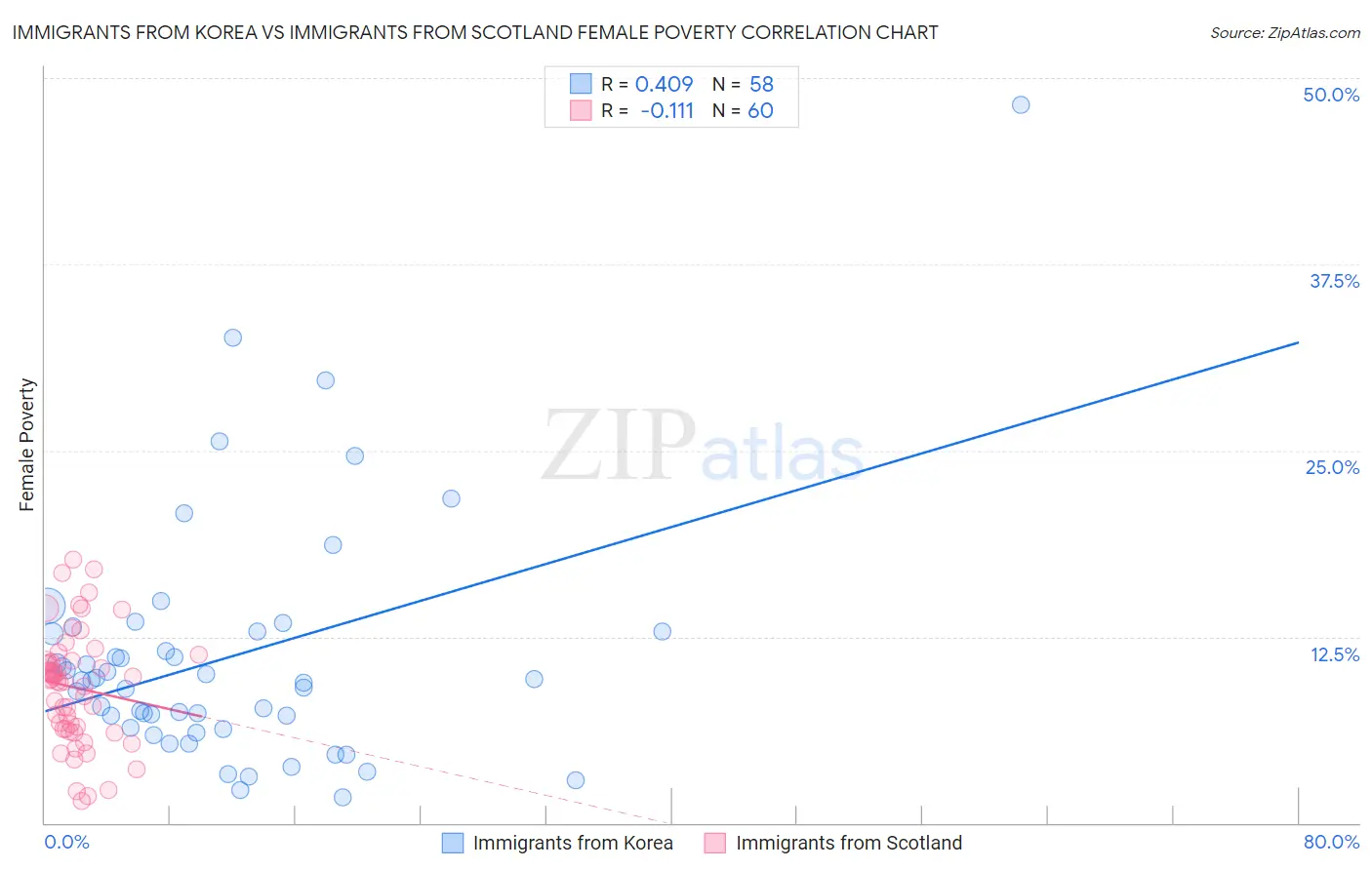Immigrants from Korea vs Immigrants from Scotland Female Poverty
COMPARE
Immigrants from Korea
Immigrants from Scotland
Female Poverty
Female Poverty Comparison
Immigrants from Korea
Immigrants from Scotland
11.7%
FEMALE POVERTY
99.6/ 100
METRIC RATING
28th/ 347
METRIC RANK
11.5%
FEMALE POVERTY
99.8/ 100
METRIC RATING
18th/ 347
METRIC RANK
Immigrants from Korea vs Immigrants from Scotland Female Poverty Correlation Chart
The statistical analysis conducted on geographies consisting of 415,882,145 people shows a moderate positive correlation between the proportion of Immigrants from Korea and poverty level among females in the United States with a correlation coefficient (R) of 0.409 and weighted average of 11.7%. Similarly, the statistical analysis conducted on geographies consisting of 196,374,584 people shows a poor negative correlation between the proportion of Immigrants from Scotland and poverty level among females in the United States with a correlation coefficient (R) of -0.111 and weighted average of 11.5%, a difference of 1.6%.

Female Poverty Correlation Summary
| Measurement | Immigrants from Korea | Immigrants from Scotland |
| Minimum | 1.7% | 1.4% |
| Maximum | 48.2% | 17.7% |
| Range | 46.5% | 16.2% |
| Mean | 11.1% | 9.1% |
| Median | 9.6% | 9.5% |
| Interquartile 25% (IQ1) | 6.4% | 6.3% |
| Interquartile 75% (IQ3) | 12.8% | 10.9% |
| Interquartile Range (IQR) | 6.5% | 4.6% |
| Standard Deviation (Sample) | 8.1% | 3.8% |
| Standard Deviation (Population) | 8.1% | 3.8% |
Demographics Similar to Immigrants from Korea and Immigrants from Scotland by Female Poverty
In terms of female poverty, the demographic groups most similar to Immigrants from Korea are Immigrants from North Macedonia (11.7%, a difference of 0.15%), Iranian (11.7%, a difference of 0.21%), Greek (11.7%, a difference of 0.23%), Immigrants from Northern Europe (11.6%, a difference of 0.32%), and Croatian (11.6%, a difference of 0.32%). Similarly, the demographic groups most similar to Immigrants from Scotland are Norwegian (11.5%, a difference of 0.040%), Bolivian (11.5%, a difference of 0.050%), Immigrants from Bolivia (11.5%, a difference of 0.12%), Eastern European (11.5%, a difference of 0.27%), and Latvian (11.4%, a difference of 0.59%).
| Demographics | Rating | Rank | Female Poverty |
| Immigrants | Lithuania | 99.9 /100 | #13 | Exceptional 11.3% |
| Lithuanians | 99.8 /100 | #14 | Exceptional 11.4% |
| Latvians | 99.8 /100 | #15 | Exceptional 11.4% |
| Immigrants | Bolivia | 99.8 /100 | #16 | Exceptional 11.5% |
| Bolivians | 99.8 /100 | #17 | Exceptional 11.5% |
| Immigrants | Scotland | 99.8 /100 | #18 | Exceptional 11.5% |
| Norwegians | 99.8 /100 | #19 | Exceptional 11.5% |
| Eastern Europeans | 99.7 /100 | #20 | Exceptional 11.5% |
| Italians | 99.7 /100 | #21 | Exceptional 11.6% |
| Swedes | 99.7 /100 | #22 | Exceptional 11.6% |
| Burmese | 99.7 /100 | #23 | Exceptional 11.6% |
| Luxembourgers | 99.7 /100 | #24 | Exceptional 11.6% |
| Immigrants | Northern Europe | 99.6 /100 | #25 | Exceptional 11.6% |
| Croatians | 99.6 /100 | #26 | Exceptional 11.6% |
| Iranians | 99.6 /100 | #27 | Exceptional 11.7% |
| Immigrants | Korea | 99.6 /100 | #28 | Exceptional 11.7% |
| Immigrants | North Macedonia | 99.6 /100 | #29 | Exceptional 11.7% |
| Greeks | 99.5 /100 | #30 | Exceptional 11.7% |
| Poles | 99.5 /100 | #31 | Exceptional 11.7% |
| Danes | 99.5 /100 | #32 | Exceptional 11.7% |
| Cypriots | 99.5 /100 | #33 | Exceptional 11.8% |